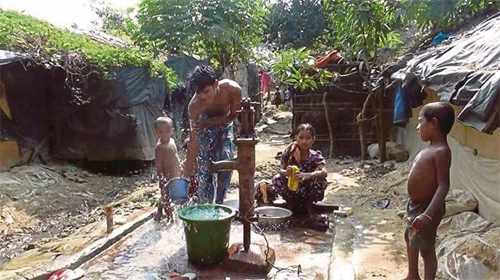SINCE violence broke out in Rakhine State, Myanmar, in August, 600,000 to 700,000 Rohingya have fled to neighbouring Bangladesh, scattered across camps and their outlying communities.
It is unknown how many remain in Myanmar, but there are believed to be more than 100,000 internally displaced persons as well as thousands more stuck in pockets between Myanmar and Bangladesh.
The situation in these camps is grim and shows no signs of improving in the middle to long term.
There is no guarantee that the required level of aid will continue to flow to the camps.
History has demonstrated that pledges of aid to victims are often only partially fulfilled.
It also is unlikely that many of the displaced will return to Rakhine State.
The Myanmar government doesn’t want them back and a huge majority of them have no interest in going back. Reports of negotiations between Myanmar and Bangladesh on the return of some of the displaced tell as much. Naypyidaw has agreed to accept only a small fraction of names put forward by Dhaka.
The only ones that the former is willing to consider are those with proper documents, which the majority of the Rohingya don’t have.
The situation is compounded by distrust and growing acrimony between both governments, and little sign of refugee resettlement programmes to third countries are in the pipeline. So, where could things head from here?
It is likely that these refugees will be in Bangladesh for the long run and the temporary refugee camps will become permanent settlements.
Again, history is rife with such examples. There are townships in Lebanon and Jordan that started off as Palestinian refugee camps and the Dadaab camp in Kenya — set up in 1991 — is still growing.
The newer Zaatari camp in Jordan catering for displaced Syrians is on its way to becoming a town.
The question is whether Bangla-desh will allow this to happen. It is struggling to host the influx of Rohingya and cannot afford it.
Its struggle to provide for its own booming population is compounded by extreme climate disasters, killing thousands and costing millions.
With elections due by the end of the year, the refugees are also proving to be a growing political problem for the government.
While it generally welcomes all the aid it can get, there are concerns in Dhaka that it will lead to cementing the permanent presence of the Rohingya in that country.
If conditions don’t improve at the camps, the refugees themselves will not want to stay there. This will lead to the most logical outcome — them leaving, either of their own accord or with encouragement by local authorities who cannot cope.
If this is the case, Malaysia is likely to be the most attractive destination for the vast majority of them.
After all, there is an established Rohingya community here, with some who have been here for up to three generations.
Even among some in Asean there is an unspoken expectation that Malaysia should just absorb the Rohingyas.
After all, Malaysia is a relatively well-to-do Muslim country, with a demand for low-wage labourers and a large immigrant-origin population to boot.
Plus, via its public statements on the plight of the Rohingya, Malaysia seems to be one of the few in this region that care about them.
But, how should Malaysia proceed? First, there needs to be a re-examination of efforts to pressure Myanmar on the Rohingya, mainly because there aren’t many Rohingya left there anymore and it is unlikely that anyone can force Myanmar to take them back soon.
While this doesn’t mean that Naypyidaw and its military should be let off the hook, our energies could be directed to other avenues that might yield more immediate results.
For example, more should be done to persuade regional signatories of the 1951 Refugee Convention and its 1967 Protocol, many of whom host fewer refugees and displaced persons than Malaysia does, to play a bigger role in the crisis.
Second, it is imperative that Malaysia continue and increase its long-term efforts to aid the Rohingya in Bangladesh, as long as the latter allows it.
We also need to work towards ensuring that others continue to do so.
Here, Putrajaya deserves kudos for getting Saudi Arabia and the United Arab Emirates to join in efforts in Bangladesh.
Third, Malaysia needs to develop a comprehensive policy on the Rohingya. This is something that this author argued for in a column in December 2016.
The imperative for such a policy has increased since then. There should be consultation with stakeholders on this policy — non-governmental organisations, aid agencies, international organisations and, most importantly, Rohingya organisations in Malaysia.
Exactly what this policy constitutes is another matter. But, it is high time for an earnest conversation among policymakers to get the ball rolling, especially if we want to be better prepared in dealing with, and, perhaps preventing, large numbers of new arrivals to our shores.





